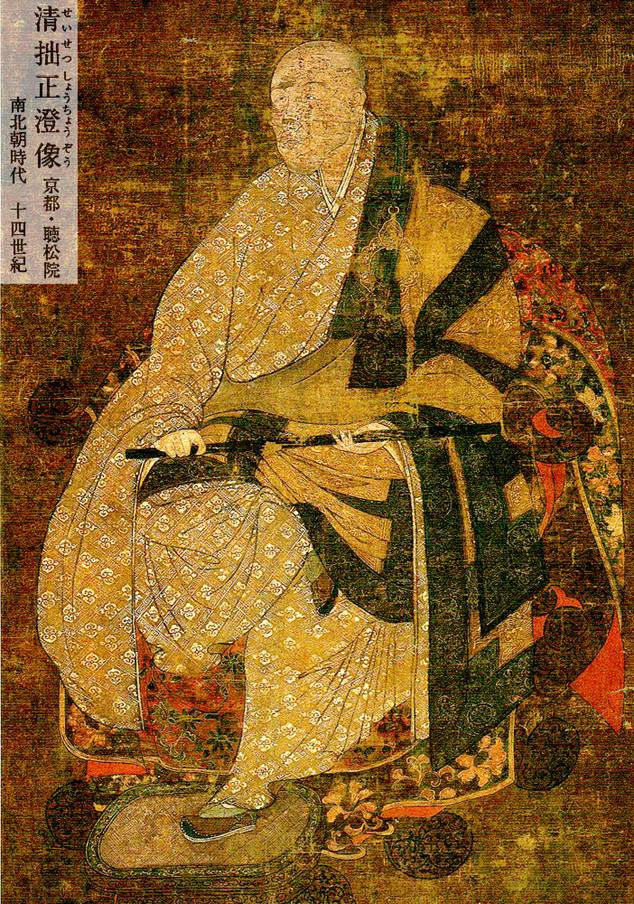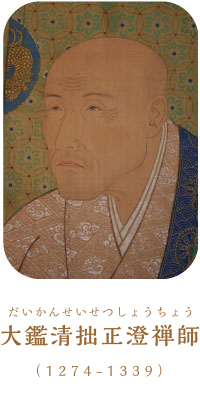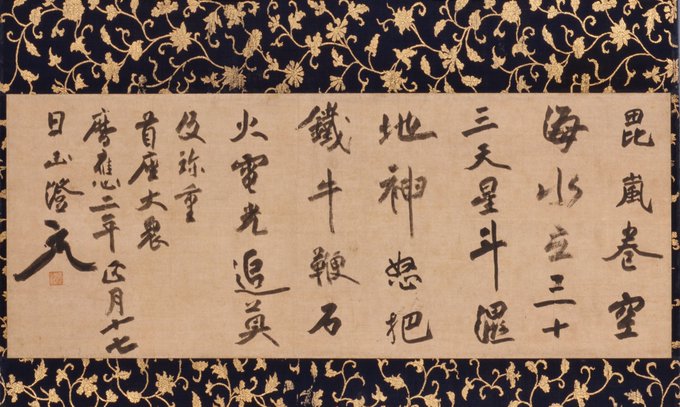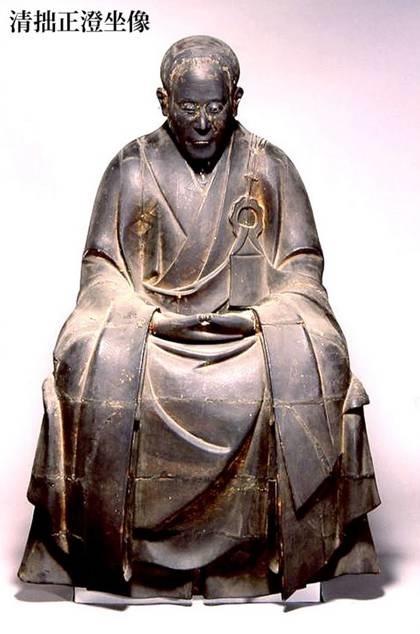ZEN MESTEREK ZEN MASTERS
« Zen főoldal
« vissza a Terebess Online nyitólapjára
清拙正澄 Qingzhuo Zhengcheng (1274–1339)
(Rōmaji:) Seisetsu Shōchō aka 大鑑 Daikan


![]()
Work in Taishō Shinshū Daizōkyō ( 大正新脩大藏經 ): T2577 大鑑淸規 Daikan shingi – Great Mirror of Regulations

清拙正澄墨蹟
Death verse (遺偈 yuige)
Written by Qingzhuo Zhengcheng, a high-ranking priest of Kennin-ji, on the day of his death which shows in the style of the writing
http://tokiwayama.org/collections/11019
http://blog.sina.cn/dpool/blog/s/blog_769fb5f30102v37d.html
国宝 清拙正澄墨蹟 遺偈
紙本墨書 36.6×92.4
南北朝時代 暦応二年( 1339 年)
中国からの渡来僧、清拙正澄が残した最後の墨痕である。
遺偈とは禅僧がその生を了えるにあたり誌されたもので、本作品は暦応二年( 1339 )正月十七日、京都建仁寺禅居庵において清拙示寂の日に揮毫された。特に花押と日付の十七は書体が乱れ、墨色も二重になっており、最後の力を振り絞って筆をふるった様子が伝わってくるようである。
奇しくもこの日は清拙の尊崇する、『百丈清規』を著した百丈懐海の忌日にもあたる。享年六十六であった。

![]()
https://en.wikipedia.org/wiki/Seisetsu_Sh%C5%8Dch%C5%8D
THE JAPANESE TEA CEREMONY
https://www.literatisociety.com/tea
When we read the phrase "the way of tea", the impression that often comes to mind is the Japanese Tea Ceremony, chanoyu 茶の湯 or chadō 茶道. We envision a tea maker whisking powdered tea in a composed and sedulous setting. We often will not associate chanoyu with the Chinese Song dynasty diancha 點茶 (whisking powdered tea). Nor will we link the Japanese sencha 煎茶 to the Chinese jiancha 煎茶 (boiling tea). Notwithstanding, sinologist Victor H. Mair states in his book The True History of Tea: “Just as chanoyu harks back to the Song custom of whisking tea, sencha traces it roots to China and the early Ming, when the Hongwu emperor issued his prohibition of milled wax tea.”
Some tea historians argue that the Japanese Zen Master Eisai Zenji 栄西禅師 (1141-1215) should be credited with the beginning of the tea tradition in Japan while others disagree. What is indisputable in Eisai's argument is in The Treaties on Drinking Tea for Life Cultivation which states: “In the Great Country (of the Song China) 大國, they drink tea, as a result of which there is no heart diseases and people live long lives. Our country is full of sickly looking, skinny persons, and this is simply because we do no t drink tea.” In spite of Eisai's admiration to "the Great Country" and its tea tradition, it is also said that Eisai and his student Dōgen Zenji 道元禅師 (1200-1253) began to bring Linji/Rinzai 臨濟宗 and Caodong/Soto 曹洞宗 Buddhism, along with the Song style of whisking tea, and tea related karamono 唐物, the Chinese objects of arts and crafts to Japan as well.
Japanese tea historian Murai Yasuhiko 村井康彥, however, avows a distinctive view: "The use of matcha (powdered tea) was transmitted from China and developed independently as chanoyu in Japan." Instead, Yasuhiko contends that the Song Buddhist monastic codes, Chanyuan qinggui 《禪苑清規》 Rules and Etiquettes of Chan Temples compiled by Buddhist monk Zong Yi 宗頤 in 1103, exerted great influence and codified with what is called the qinggui/shingi 清規 rules at the Japanese Zen temples with the help of Chinese Buddhist missionaries Lanxi Daolong/Rankei Dōryū 兰溪道隆 (1213-1278) and Qingzhuo Zhengcheng/Seisetsu Shōchō 清拙正澄 (1274–1339). Chali/Sarei 茶禮 "the tea rituals and rules" were a part of the qinggui/shingi rules. In this sense, Yasuhiko declares: "chanoyu was emerged from the sarei of Zen".